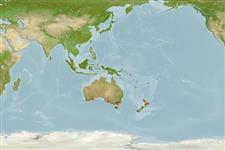>
Atheriniformes (Silversides) >
Atherinidae (Silversides) > Atherininae
Etymology: Atherinason: Greek, atherina, the Greek name for the eperlane; 1770, + Greek particle, son = whole (Ref. 45335).
More on author: Richardson.
Environment: milieu / climate zone / depth range / distribution range
Écologie
marin; profondeur 1 - 30 m (Ref. 9002), usually 1 - 4 m (Ref. 9002). Temperate; 34°S - 40°S
Eastern Indian Ocean: endemic to southern Australia.
Taille / Poids / Âge
Maturity: Lm ? range ? - ? cm
Max length : 9.0 cm TL mâle / non sexé; (Ref. 9002)
Description synthétique
Clés d'identification | Morphologie | Morphométrie
Épines dorsales (Total) : 6 - 11; Rayons mous dorsaux (Total) : 9 - 13; Épines anales: 1; Rayons mous anaux: 11 - 14. Body slightly compressed and sides flattened (Ref. 9002).
Found on the continental shelf, inshore waters (Ref. 7300). Often found in estuaries and recorded in coastal bays (Ref. 9002).
Life cycle and mating behavior
Maturities | Reproduction | Spawnings | Egg(s) | Fecundities | Larves
Paxton, J.R., D.F. Hoese, G.R. Allen and J.E. Hanley, 1989. Pisces. Petromyzontidae to Carangidae. Zoological Catalogue of Australia, Vol. 7. Australian Government Publishing Service, Canberra, 665 p. (Ref. 7300)
Statut dans la liste rouge de l'IUCN (Ref. 130435)
Menace pour l'homme
Harmless
Utilisations par l'homme
Outils
Articles particuliers
Télécharger en XML
Sources Internet
Estimates based on models
Preferred temperature (Ref.
123201): 15.3 - 18.9, mean 17.1 °C (based on 170 cells).
Phylogenetic diversity index (Ref.
82804): PD
50 = 1.0000 [Uniqueness, from 0.5 = low to 2.0 = high].
Bayesian length-weight: a=0.00537 (0.00237 - 0.01216), b=3.10 (2.91 - 3.29), in cm total length, based on LWR estimates for this (Sub)family-body shape (Ref.
93245).
Niveau trophique (Ref.
69278): 3.3 ±0.4 se; based on size and trophs of closest relatives
Résilience (Ref.
120179): Haut, temps minimum de doublement de population inférieur à 15 mois (Preliminary K or Fecundity.).
Fishing Vulnerability (Ref.
59153): Low vulnerability (10 of 100).
